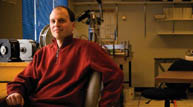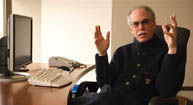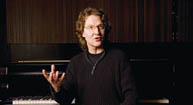By Neale McDevitt
Ultra-Videoconferencing is the next best thing to being there
In many ways, it was just another music class. On November 17, 2005, Gordon Foote, professor at McGill’s Schulich School of Music, conducted a group of McGill jazz musicians, coaching and guiding their performance, nodding at a particularly well-chosen phrase, and controlling the tempo with the fluttering hands that are the arcane sign language of music. Near the end of the session, Foote picked up his sax and jammed with the ensemble. The subtle give-and-take graced the gathered audience with that one-of-a-kind creativity found only in snowflakes and live music. One small detail differentiated this jam session from any other—namely, the 3,700 kilometres that separated teacher from students.

Foote was in Seattle taking part in the prestigious Supercomputing 2005 conference, in which world experts from academia and industry gathered to discuss high-performance computers and networking, while the jazz band following his lead was playing in Montreal. The seamless transcontinental connection linking convention hall and music studio was provided by McGill’s Ultra-Videoconferencing system.
Developed by John Roston, Director of McGill’s Instructional Multimedia Services, Jeremy Cooperstock, Professor of Electrical and Computer Engineering, Wieslaw Woszczyk, founding director of the Centre for Interdisciplinary Research in Music Media and Technology (CIRMMT), and software developer Stephen Spackman, the system is one of the most advanced such technologies in the world—it won the award for “Most Innovative Use of New Technology” at the Seattle show.

“When you’re getting a panoramic view of an entire room where life-size people are in such great detail that you can count the hairs on their arms, you’re no longer thinking about the technology—now you’re interacting with real people,” says Roston.
On the West Coast, a trio of 65-inch plasma screens made convention-goers feel as if they were in the same room as the band. More importantly, Foote was able to make subtle corrections in fretting technique by what he saw onscreen—a far cry from the muddy, low-definition picture that has been the bugaboo of traditional videoconferencing.

Unlike conventional videoconferencing, which expends considerable effort trying to reduce bandwidth requirements, the Ultra-Videoconferencing system transmits data between the computers at both ends of the connection without any data compression. This helps keep the system latency—the end-to-end delay users experience—to a minimum, and allows for the natural give-and-take of conversation or musical performance. As Cooperstock notes, for such applications, “latency is the interaction killer.”
The system sends video and audio streams back and forth between Montreal and Vancouver along the high-bandwidth CA*net 4 network, a Canadian government-funded system of fibre optic cables that zip information from coast to coast at two-thirds the speed of light. While home users of high-speed Internet typically receive three megabits of data per second, McGill’s Seattle team drew on speeds of four gigabits per second—a better-than-thousand-fold increase that can transmit the equivalent of an entire DVD of information every 10 seconds.
Although Ultra-Videoconferencing has myriad applications, including distance education, remote sign language interpretation and telemedicine, Stephen McAdams, Director of CIRMMT, has his own view of the system’s potential—one that is dear to his heart. “Our job at CIRMMT is to take these technologies and make art out of them,” he says.
In the near future, McAdams sees Ultra-Videoconferencing being used to solve an old problem in the recording industry. “The best studio musicians are scattered all over,” he says. “Soon we’ll be able to set up studio situations where guys are jamming and recording together from all over the continent.”
Further improvements will include additional cameras for eye-to-eye contact between musicians and more audio channels to enhance the surround-sound effect so that sounds will not only be transmitted in real time, but also from the direction they originated. Vibro-sensory equipment is being updated, allowing an audience to feel each clickity-clack of a tap dance troupe’s performance from a remote location. “It’s the whole notion of telepresence,” says McAdams. “We want to make you feel as if you are in the same space as the person you are communicating with.”
Major funders of the Ultra-Videoconferencing project are CANARIE Incorporated and Valorisation-Recherche Québec.
For more on CIRMMT, please see the McGill Reporter
